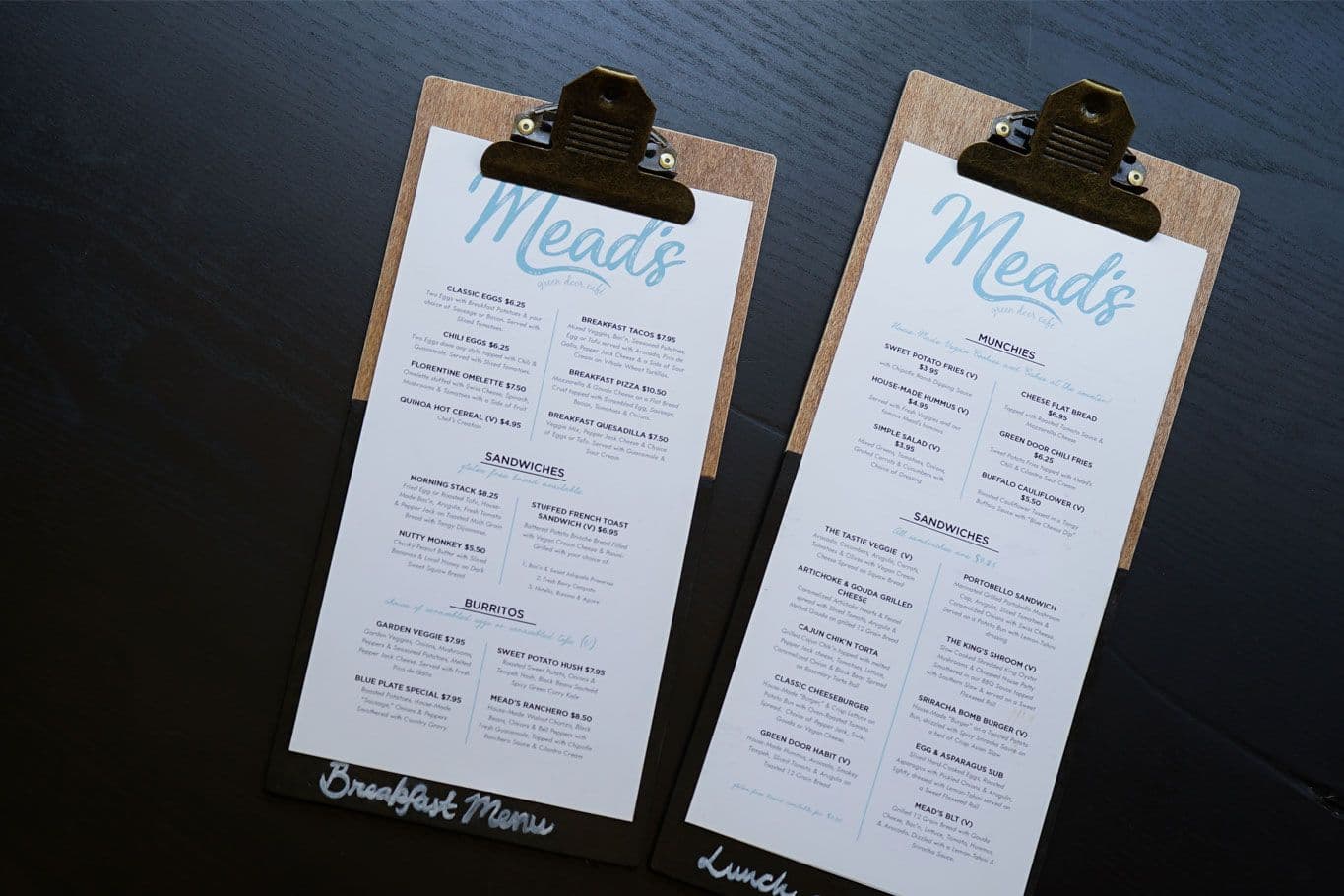Great menu design makes it easy for customers to find what they want, improving the restaurant’s customer experience. Combined with effective menu engineering, menu design can guide the customer’s eye to your best products, encouraging sales and maximizing profits. Here are a few examples of restaurant menu designs and how they can help your business.
Text-only menu
Great for: Pizza shops, coffee shops, fine dining restaurants, food trucks, and kiosks
Text-only menus provide a list of all available menu items without supporting graphics or pictures. While minimalism hinders the customer’s ability to visualize your products, the lack of clutter gives your menu the appearance of cleanliness and professionalism. Additionally, the space efficiency allows you to list more items on a single page, saving ink and paper.
The text-only menu is suitable for establishments that serve products that are so commonplace they require no supporting imagery, such as pizzas, burgers, tacos, and coffee. If your storefront already has food on display or moves fast enough that customers can see the products moving in and out, adding pictures to your menu might be redundant.
Fine-dining restaurants also use text-only menus to exude an air of sophistication. Instead of just listing dish names, they include key ingredients, highlighting the essence of the meal rather than its appearance.
Image-heavy menu
Great for: Cafes, fast food restaurants, drive-thrus, ghost kitchens, and kiosks
An image-heavy menu is the opposite of a text-heavy menu: it attaches images to nearly all products on the menu. This design type is suitable for fast-moving food establishments, such as fast food restaurants, kiosks, and drive-thrus. The visuals entice customers to your products, encouraging quick sales.
The issue with image-heavy menus is clutter. With images, you might lack space to include menu descriptions or ingredients. And if you have too many menu items, you may struggle to include all images in a single space without compromising quality or sizing. This means that image-heavy menus are better for establishments with fewer products.
Image-light menu
Great for: All types of restaurants
A happy medium between text-only and image-heavy menus is image-light menus. Rather than visualizing all products, the image-light menu only visualizes the items the establishment is most keen on selling. This attracts customers to the items that make the most money while still showing the other available options.
Like with image-heavy menus, the issue with image-light menus is clutter. Where menus that represent all items visually might have an easier time building a uniform layout, creating an image-light menu requires a keener sense of graphic design. You need to determine how to make all visual elements, including text, images, and graphics, work harmoniously on a single page.
The trick to designing an effective image-light menu is going back to your menu engineering. You can break items down by category to determine which to feature on your menu. In 7shifts, we tend to divide our menu items into stars, puzzles, plowhorses, and dogs.
| Profitability | Popularity | Include an image? | |
| Stars | High | High | Yes |
| Puzzles | High | Low | Yes |
| Plowhorses | Low | High | No |
| Dogs | Low | Low | No |
- “Stars” (high profit, high popularity): As your most popular and profitable items, stars should typically appear more prominently on your menu, near the top and with an image.
- “Puzzles” (high profit, low popularity): These are the items that are highly profitable for the establishment but attract fewer customers. If you want to increase their popularity, you should make them as prominent on your menu as your stars by adding images.
- “Plowhorses” (low profit, high popularity): If a menu item is popular but generates lower margins, you don’t need to put in extra effort to make it stand out, so it’s best not to include an image. Allow the hard-hitters to shine brighter.
- “Dogs” (low profit, low popularity): Out of a need to accommodate all types of customers, such as picky eaters and customers with dietary restrictions, you may still want to include unpopular and low-profit items on their menu. Since these items only sell in fringe cases, visibility and visualization should not be a priority.
For example, here is the boba shop Chatime’s menu. It shows images of selected products and uses symbols to denote the popularity. Heart symbols highlight plowhorses like Chatime Milk Tea and Jasmine Milk Tea, which are bestselling items that might not be as profitable. Images are available for puzzles like the Jasmine Green Tea and the Chocolate Mousse. Meanwhile, their stars get both images and symbols. Dogs receive no visible distinctions.
Browser menu
Great for: Reservation-intensive restaurants, delivery-intensive restaurants, and ghost kitchens
A great way to represent all menu items visually without compromising space is to create a browser menu on your restaurant website. The ability to scroll allows you to represent multiple items without cluttering the physical page.
Online restaurant menus make for great marketing tools. They show your customers what you offer without requiring them to enter your physical store. Additionally, most browser menus also alternate as ordering systems, allowing customers to click items for advanced reservations or deliveries.
The problem with browser menus is loading speed. Graphic-heavy websites require significant power to load, which can negatively impact user experience. To ensure that your website performs well, be particular about attributes like sizing, compression, and format when uploading images. Find a happy medium between small and readable, and avoid animated GIFs.
Mobile menu
Great for: All types of restaurants except for fast food restaurants, food trucks, and kiosks
Another alternative to physical menus is the mobile menu. Like browser menus, mobile menus let you include more images than physical menus, thanks to the ability to scroll or add new pages infinitely. However, unlike browser menus, mobile menus offer less space to display photos, which makes them unsuitable for establishments with large product catalogs. Mobile menus typically rely on QR codes to reach the customer.
However, despite how fast QR code technology is, customers of fast-moving establishments still consider it an extra step and prefer viewing a physical menu on the storefront and ordering straight from the cashier. Therefore, it’s best not to use QR code menus for fast food restaurants, food trucks, and kiosks.
Design a better restaurant management workflow with 7shifts
The right menu design effectively communicates your brand image while encouraging sales. By paying attention to visual elements, such as image quantity, layout, and display type, you can connect your customers with your products, making their restaurant experience memorable.
Restaurant operators wanting to improve all aspects of customer experience should streamline restaurant management through technology. 7shifts puts multiple restaurant management tasks under a single platform, allowing you to automate scheduling, time tracking, team communication, and payroll calculation to increase efficiency. Our streamlined solutions help you save hours on manual tasks, freeing your schedule up for higher-impact business decisions.

Rebecca Hebert, Sales Development Representative
Rebecca Hebert
Sales Development Representative
Rebecca Hebert is a former restaurant industry professional with nearly 20 years of hands-on experience leading teams in fast-paced hospitality environments. Rebecca brings that firsthand knowledge to the tech side of the industry, helping restaurants streamline their operations with purpose-built workforce management solutions. As an active contributor to expansion efforts, she’s passionate about empowering restaurateurs with tools that genuinely support their day-to-day operations.
